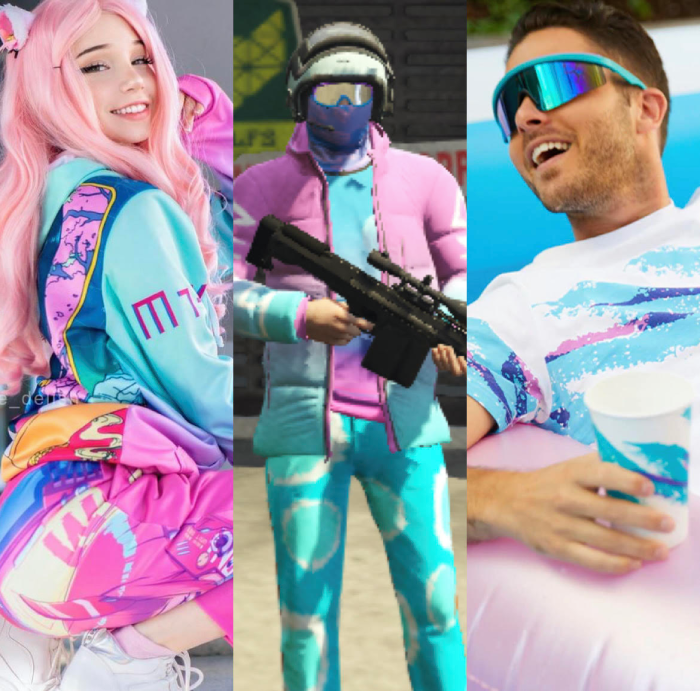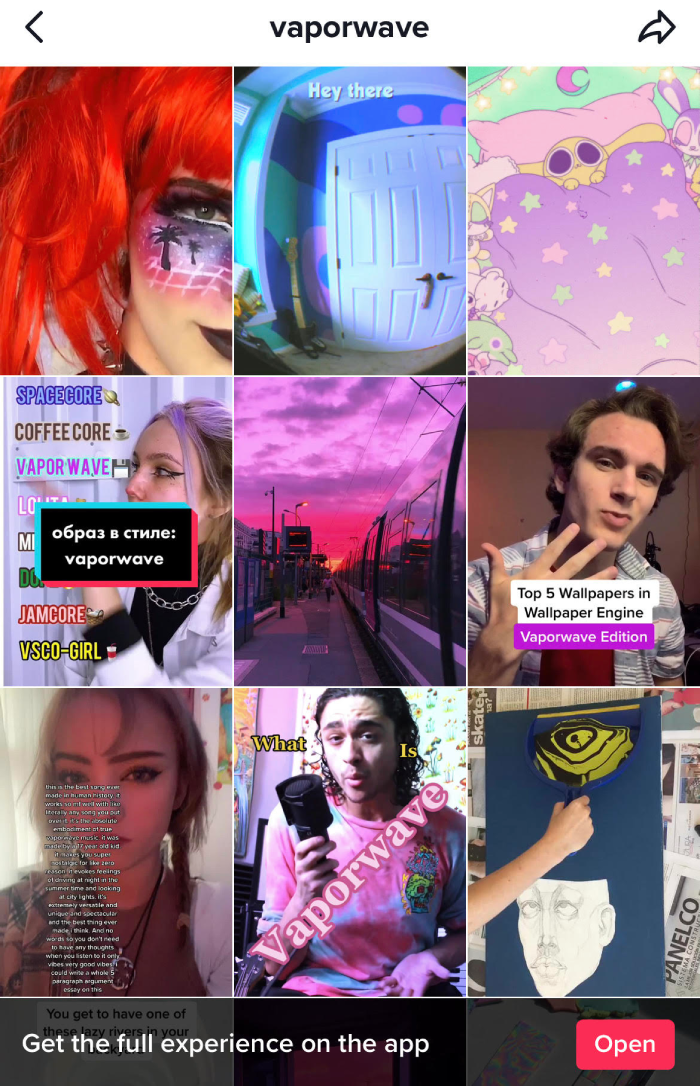The Terrifying Rise of Post-Vaporwave
[DISCLAIMER] The statements below are purely for entertainment, and not meant to be seen as anything other than that. Any references to the likeness of specific people, companies, or events are purely coincidental. This blog post is a satirical portrayal of a non-existent genre, so please do not @ me.
With that said,
Please enjoy.
Post-Vaporwavers
What is Post-Vaporwave
In the year 2022, a post-vaporwave internet emerged in an increasingly de-centralized, de-stabilized, and hyper-globalized world. Despite rapidly increasing technological progress, many people within the post-vaporwave sphere choose to live in a bubble of fetishized aesthetics of the 80s, 90s, and an incoherent amalgam of the two. This new breed of subculture allows for a faux-authentic lifestyle that aggressively glorifies memes, corporate machinations, obsolete products, and gaudy iconography.
This kind of hipster applauds their own inability to come up with anything new. You would think we had enough magenta and teal gradients in vaporwave, but you were wrong, oh how you were wrong. Vaporwave long suffered the consequences of having no standard for quality, quickly bubbling up and being overwhelmed by waves of mediocre music sometime after 2014, when anyone’s artistic expressions, however deranged, were ‘valid’, allowing for the bloated neon demon it’s seen as today.
In contrast to original vaporwave that mostly mocked and parodied consumer-culture, post-vaporwave celebrates capitalism with feigned naivete, secretly priding itself on how well it can mask its greed, ambition, and turpitude with trite simulacra meant merely to impress on an observer like a fat child’s face against the window of a candy shoppe. This new paradigm gleefully perpetuates the dystopian reality that it once subtly cautioned against.
At one point in time, lets say 2011, the genre was dripping with sincerity and curious flirtation with the potential for a new age punk mentality, vaporwave would go on to collapse on itself by becoming quasi-popular on social media, inevitably devolving into its lowest common denominators. Post-vaporwave is “popular” today because it’s easy to classify, whereas vaporwave at its start was not as easily put into a box, or rather, it was just different than most other things at the time when put in the context of culture, music, and art.
Post-Vapor Moment
“It went from being ‘is this Vaporwave?’ to ‘THIS is Vaporwave!’”
Post-vaporwave became the most dominant form of vaporwave around 2015, once enough followers of the style abandoned all philosophical, anti-capitalist, and Marxist tendencies that arguably fostered many of the genre’s ideas surrounding music copyright, creative commons, and manipulation of nostalgic artefacts as acts of rebellion circa 2011.
Increasingly pro-capitalist, the post-vaporwave idols and their followers eventually were able to organize a new a reality for the vaporwave scene that once set into motion was never able to return to its original uniqueness and charm. Post-vaporwave is the delusion of appearing counter-culture, by assimilating into online communities that offer a variety of options to purchase an identity where you can find acceptance, if you offer yourself up at the alter of monetization.
This fate of vaporwave was expected, as almost every genre that has been assigned recognizable stylistic tropes become more of a costume than an actual identity. The original sentiment that created vaporwave is no longer possible to replicate, because those times were different, and circumstances changed. The Post-vaporwave era proliferated because it became accessible, and easy to replicate, eventually ending up just tired clichés. It became the fedora of musical genres.
Fancy making this company richer by feeding into the illusion that wearing this gaudy pattern makes you cooler?
The Death of Anonymity
A big part of what made vaporwave special before the fall was anonymity. The mystique of the these anon artists was refreshing because releases weren’t overshadowed by the ego of the producer, who truthfully didn’t really need to be known in order for anyone to enjoy an album, and I would argue it made for a better experience. For the same reasons Daft Punk wore helmets, I think producers were better for being discrete about their identities.
In an internet world plagued by just god-awful people, the mentally disturbed, and idiotic trolls, it was almost a privilege not knowing that a producer you liked wasn’t the terrible human being that they likely were. Thanks to Twitter, Reddit, Twitch, and Discord, we found every avenue to interact with whatever misguided hot take our favourite post-vaporwave artist had in the oven.
Vaporwave became another game of talking heads, idling on about any and every topic without a sense of direction for where any of this was going, because they knew there was no direction or destination, which paradoxically became the point.
Post-vaporwave is the opposite of vaporwave in that it encourages recognition. It wants you be seen, heard, and use any platform available to broadcast yourself. This development coincided with the expanding concept of web 2.0, where plastering your face and name everywhere carried the intoxicating effect of niché pseudo-fame.
Sadly, for vaporwave, many artists in the style who were once intriguing ghostly presences on the fringe of the internet’s most interesting music scene are today just more of the same stardom-starved post-vaporwave clout vampires watching, waiting, for anyone with a glimmer of curiosity about the scene in their eye to suck the cryptocurrency out of. *I know that was a run-on sentence, I don’t care, it was worth it.
And just like that, you’re a post-vaporwave icon.
The Post-Vaporwave Virtual Plaza
The virtual Plaza was once an imagined fantasy of never-ending escalators slinking onto infinite floors of a pristine mall dotted with perfect storefronts and immaculate decor that stays frozen in time yet hauntingly satisfying. This virtual plaza predicted the multiverse of online shops, print-on-demand, drop-shipping, and micro-DIY store boom of the mid 2010s. Internet shopping became so integrated into almost every facet of daily life that it became practically inescapable at some point mid-decade.
This same self-gratifying need to purchase things we don’t need today is the same that drove millions of Americans back in the 80s & 90s to practically live in these glowing capitalist oases. Malls were sinisterly crafted to create a feeling of almost being in a fantasy, akin to casinos in Las Vegas; hyper-reality to attract those looking to idle indefinitely.
Post-vaporwave is the over-saturation of products tagged with the word vaporwave; a chaotic maelstrom of synthwave, retrowave, chillwave, 80s, 90s, forcibly smashed with other nostalgic references like distressed action figures. None of it really makes sense, but we long since abandoned sense, child.
We lost so much sense that the most successful, and profitable post-vaporwave products are the floral aesthetic of a 99-cent can of iced tea, and a whimsical bluish-white brush stroke on a disposable paper cup. Anyone reading this in the future will chuckle at the thought, but yes, these were the symbols of unity amongst post-vaporwavers. Undoubtedly, a metaphor for what kind of intrinsic values were being measured.
You can find those two designs on almost anything you could ever want, and if it doesn’t exist, you can have it made to order. At one point these aesthetics were sort of novel, and not really considered trendy, but post-vaporwavers created a frenzy around these graphics that made it more about affiliation to the scene than actually thinking these corporate-sponsored products were in any way meaningful as much as they were empty.
A must-have.
Post-Vaporwave’s Music is an Afterthought
I’ve been listening to vaporwave since 2011, and before that I was listening to chillwave, synthwave, nu-rave, and electroclash before that, among other weird shit. Sub-genres are not a new concept to me, and I have collected a wealth of useless information regarding these styles throughout the years. Much of what I based this satire on was discussed by the creator of Floral Shoppe 2.
Floral Shoppe 2 was the birth of post-vaporwave. It became about who could abuse the genre’s stylistic tropes to ‘out-vaporwave’ everyone else, even at the cost of making listenable music. This album’s creation was the metaphorical Large Hadron Collider experiment that caused the rift in the vaporwave universe’s space-time, allowing post-vaporwavers to cross over into this dimension. [queue laugh from audience]
I think music for post-vaporwavers doesn’t really matter, though some will say they have an affinity for it regardless of if they actually enjoy it or not. What matters most to this subset of fan is being a part of the scene, aesthetic choices, and collectable cassette tapes that get bricked into a wall never to be heard again.
I know you’re probly shaking your head saying that YOU aren’t one of those post-vaporwavers, no, you actually like to hear good production quality and listenable music. I’m glad to hear that. There are all sorts of people and I’m in no way suggesting every single post-vaporwaver is the same.
There is however always a majority that exhibit predictable behaviors when it comes to these sorts of things, so really its all very ephemeral and hard to pin down, but we try anyway, don’t we? But, I digress. Some prefer to listen to the music, others prefer to groom, but thats a whole ‘nother story about what the post-vaporwave community can foster.
The Future of Post-Vaporwave
At some point in the last decade, something happened that knocked this universe into another, possibly something with that damned Large Hadron Collider. Maybe that’s what they’re trying to tell us with all these stupid marvel movies talking about multiple timelines crashing into each other and what not [conspiracy alert]. When will they learn to stop messing with time-space!
What might post-vaporwave become in the future? Possibly, it could become what newer generations start to think is an actual depiction of the past, without ever realizing that it was all just a joke—a joke on them.
-Van
edited 1/10/2024AUTHOR
Van Paugam is an Internationally-Acclaimed DJ and leading figure specializing in 70s and 80s Japanese Music, dubbed City Pop. He has organized and hosted over 100 events globally dedicated to the style, and actively promotes Japanese culture while on the board of the Japanese Arts Foundation of Chicago. He has been featured on CNN, NHK, and many other publications for his dedication to City Pop. Van is credited with being the first person to begin popularizing City Pop online through his mixes on YouTube in 2016, and subsequently through live events. Learn More…







![Tomoko Aran - Fuyu Kukan [2024 Reissue]](https://images.squarespace-cdn.com/content/v1/5bd7707c11f7847c45b4b9dd/1689118417870-VK5509S75OAQ8XLR9TEG/ab67616d0000b273138d0143d948a5314d1aea19.jpg)
![Kingo Hamada - Midnight Cruisin' [Reissue]](https://images.squarespace-cdn.com/content/v1/5bd7707c11f7847c45b4b9dd/70b59ba1-850e-4a6d-a827-34e221a172bf/WQJL-159.jpg)
![Mioko Yamaguchi - Tsukihime Moonlight [Reissue]](https://images.squarespace-cdn.com/content/v1/5bd7707c11f7847c45b4b9dd/1688493110328-NTAQQVZ245PY48X3I6H4/MHJL-278.jpg)
![Yurie Kokubu - Steps [Reissue]](https://images.squarespace-cdn.com/content/v1/5bd7707c11f7847c45b4b9dd/1688492253619-240QYD9A83G0GLRKQ08U/MHJL-282.jpg)
![Anri - Natsu Ban [New EP]](https://images.squarespace-cdn.com/content/v1/5bd7707c11f7847c45b4b9dd/1687905964336-9PV1QDIP2YNMEKDHS14R/Screenshot+2023-06-27+174101.png)
![Anri - COOOL [Reissue]](https://images.squarespace-cdn.com/content/v1/5bd7707c11f7847c45b4b9dd/1682575601801-C2BEL9RM2RUHJS9OBSL1/ab67616d0000b27339b329eaf36f09af3c2356f4.jpg)
![Anri - Timely!! [Reissue]](https://images.squarespace-cdn.com/content/v1/5bd7707c11f7847c45b4b9dd/1682575330424-OPVMZCJ0GUYHW6P0X5UT/R-5126669-1638115528-6607.jpg)
![Anri - Heaven Beach [Reissue]](https://images.squarespace-cdn.com/content/v1/5bd7707c11f7847c45b4b9dd/1682574623734-QWHWV5NQSM71KRKK8K6G/R-4777778-1618165602-9892.jpg)
![Anri - Bi Ki Ni [Reissue]](https://images.squarespace-cdn.com/content/v1/5bd7707c11f7847c45b4b9dd/1682575025867-NBUJHCR4R997RWTHJ71K/R-6161494-1640871595-6430.jpg)
![Miki Matsubara - Pocket Park [Reissue]](https://images.squarespace-cdn.com/content/v1/5bd7707c11f7847c45b4b9dd/1682919786676-RDDRQMQ80QIJP8SD61JS/IMG_8996.jpeg)
![Miki Matsubara - Who Are You [Reissue]](https://images.squarespace-cdn.com/content/v1/5bd7707c11f7847c45b4b9dd/1682919471387-FEXQME3R87Z0GGN8OM30/IMG_8995.jpeg)
![Taeko Ohnuki - Mignonne [Reissue]](https://images.squarespace-cdn.com/content/v1/5bd7707c11f7847c45b4b9dd/1677631540050-MB8QQ48ZP5NKH0P9F61Z/31qFb8S%2BGKL.jpg)
![Tatsuro Yamashita - Go Ahead [Reissue]](https://images.squarespace-cdn.com/content/v1/5bd7707c11f7847c45b4b9dd/1677630549318-VK4691LKREAD8ILYCDTG/BVJL-93.jpg)
![Yurie Kokubu - Relief 72 Hours [Reissue]](https://images.squarespace-cdn.com/content/v1/5bd7707c11f7847c45b4b9dd/1677629440079-6RWRK2ZWERH37N9Y30KE/%E5%9B%BD%E5%88%86%E5%8F%8B%E9%87%8C%E6%81%B5-yurie-kokubu-relief-72-hours-Cover-Art.jpg)
![Momoko Kikuchi - Tropic of Capricorn [Reissue]](https://images.squarespace-cdn.com/content/v1/5bd7707c11f7847c45b4b9dd/1674797802522-6G0J6KOSVEHW51M7EIWH/Tropic+of+Capricorn.jpg)
![Momoko Kikuchi - Ocean Side [Reissue]](https://images.squarespace-cdn.com/content/v1/5bd7707c11f7847c45b4b9dd/1674798147688-5U1MW4DHPF1JJCB97Q5Z/Ocean+Side.jpg)
![Momoko Kikuchi - Escape From Dimension [Reissue]](https://images.squarespace-cdn.com/content/v1/5bd7707c11f7847c45b4b9dd/1674797753044-X7EKMKXREYA8ZSZD1DAA/escape+from+dimension.jpg)
![Momoko Kikuchi - Adventure [Reissue]](https://images.squarespace-cdn.com/content/v1/5bd7707c11f7847c45b4b9dd/1674797693224-VN0M90A8BM9LPTYWBSB5/Adventure.jpg)
![Hitomi Tohyama - Imagination [Reissue]](https://images.squarespace-cdn.com/content/v1/5bd7707c11f7847c45b4b9dd/1674797015412-B47AFOTZHWA2CO5BUMAA/Imagination.jpg)
![Hitomi Tohyama - Sexy Robot [Reissue]](https://images.squarespace-cdn.com/content/v1/5bd7707c11f7847c45b4b9dd/1674714815791-4KT0NM9S4ED18FLQKHKC/sexy+robot.jpg)
![Tatsuro Yamashita - Greatest Hits [Reissue]](https://images.squarespace-cdn.com/content/v1/5bd7707c11f7847c45b4b9dd/1674713862344-KZQM2GX3TF0Y8XODXT1P/R-3282359-1533691121-1914.jpg)
![Tatsuro Yamashita - For You [Re-Press]](https://images.squarespace-cdn.com/content/v1/5bd7707c11f7847c45b4b9dd/1674713532165-3F6PUTT1U16F9RKFDKCQ/R-2179374-1576817857-6649.jpg)
![Tatsuro Yamashita - Ride On Time [Reissue]](https://images.squarespace-cdn.com/content/v1/5bd7707c11f7847c45b4b9dd/1674713298310-CX7AAYGDCK9VRC09V8F7/R-3282392-1341996717-7068.jpg)
![Tatsuro Yamashita - Moonglow [Reissue]](https://images.squarespace-cdn.com/content/v1/5bd7707c11f7847c45b4b9dd/1674712985847-GAAP57FYG3W34MT0KX6Z/R-2063296-1594137375-1639.jpg)
![Tatsuro Yamashita - It's A Poppin' Time [Re-Press]](https://images.squarespace-cdn.com/content/v1/5bd7707c11f7847c45b4b9dd/1674711577552-6OG8AHZTL0A0VMOFACE6/R-5223079-1601375868-4345.jpg)
![Tatsuro Yamashita - Spacy [Reissue]](https://images.squarespace-cdn.com/content/v1/5bd7707c11f7847c45b4b9dd/1674711439752-GP5PA47QCYGU14Q1F8I9/R-1006498-1322902455.jpg)
![Tatsuro Yamashita - Circus Town [Reissue]](https://images.squarespace-cdn.com/content/v1/5bd7707c11f7847c45b4b9dd/1674710622935-WAUHPKKQAQSUPFH8NC0G/BVJL-95.jpg)





Barber Beats are simply a sub-genre of the micro-genre Vaporwave, or a spin-off, whatever. It was coined by Aloe City Records to refer to Haircuts for Men, who is often credited with popularizing the style and aesthetic. The sub-genre as an established style began gaining notoriety in early 2022, making it one of the newest iterations of Vaporwave.